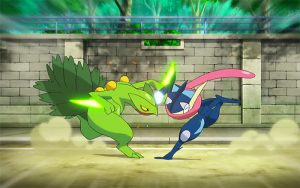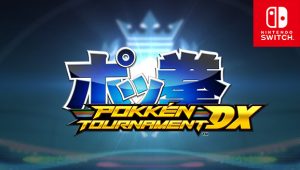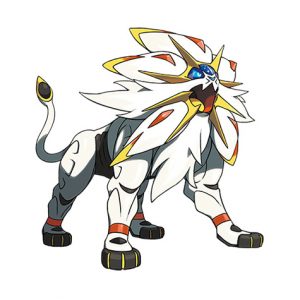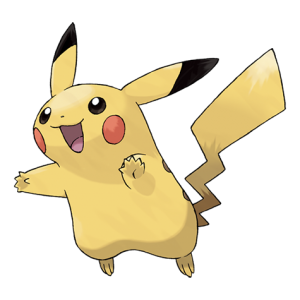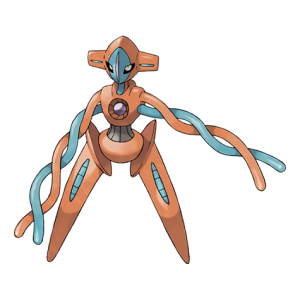When putting out a new game in a series as long-running as Pokémon, it can be difficult to determine which mechanics have remained for as long as they have because they’re actually that engaging, and which have just stuck around due to tradition. And, well, Pokémon has been mired a bit too much in sticking with tradition for a while now. It often feels like with each new game, it maybe takes one small step at a time by improving something that desperately needed to be changed, while ignoring everything else that could possibly need improvement. Heck, it took four whole games before Game Freak finally adjusted what attack stat moves would draw from based on the move rather than the type, and five games before Game Freak finally allowed TMs to be permanent items.
We feel that Pokémon Sun & Moon is a brave step forward for the series in that it finally does away with a lot of unnecessary bloat and streamlines the game, making it satisfying for both casual players and hardcore fans alike. It’s not totally perfect (the removal of Super Training from X & Y hurts deep), but Sun & Moon is the freshest that the Pokémon franchise has felt since Gold & Silver released over 15 years ago. The addition of several new features has allowed for some real creativity in both the single player campaign, as well as some fun new toys to mess around with in the competitive game.
Regional Variants
One of the biggest claims to fame the Alola region holds over any other region in the Pokémon franchise is how, for the first time ever, Pokémon can hold significant differences from previous iterations. While on the surface this may seem to be a simple design difference, in actuality, these Alolan variants can affect a Pokémon’s typing , their Ability, and their entire moveset to boot. For example; up until now, Golem, from the original Red & Blue games, was always a Rock/Ground type Pokémon. Sun & Moon, however, have changed good ol’ Golem into Rock/Electric, changing its moveset to naturally have some Electric moves to make use of its new typing, and has been given a new Ability in Galvanize, which changes any Normal-type move into an Electric move.
While this all sounds neat, you may be asking why this is important at all. Why not just make a new Pokémon with everything listed above rather than changing Golem? A big part of why this is important is due to an issue in a lot of competitive games that’s often referred to as “power creeping”. See, one of the big appeals with buying a new game or expansion in a franchise, whether it’s a video game or a card game, is to get the new, more powerful equipment or items. So, for Pokémon, that would mean the newer, stronger Pokémon. However, when the next game or expansion comes, this means that once again, there has to be newer, even stronger gear (or Pokémon, in this case); which slowly makes the original items less and less relevant. Alola variants give Game Freak an opportunity to rework original Pokémon that were falling by the wayside a new chance in the competitive game.
What’s great about this as well is that it sets the precedent for later games to continue to incorporate this as a trend. Several of Nintendo’s past attempts to stave off power creeping were simply one off additions that worked at the time, such as with the addition of Abilities in Ruby & Sapphire or adding new evolutions to current Pokémon, but once they were added, there was little they could do to keep expanding on it (outside of oddball ideas like including Hidden Abilities so a Pokémon could have a choice between abilities). Just set aside the notion of specifically “Alola” versions; every region from here on out could have its own versions of different Pokémon. The series can continue reworking older Pokémon with every single game, and not necessarily just with the original 150 either. Heck, even if some of the new Alola Pokémon end up not being particularly useful (looking at you, Alolan Dugtrio), even those Pokémon can be reworked with a new form.
Poké Ride
The land, the sea, the sky—with the power of Ride Pokémon, you can go anywhere! #PokemonSunMoon pic.twitter.com/8jFXTLcmlR
— Pokémon (@Pokemon) August 1, 2016
For those who haven’t picked up the game yet, the Poké Ride is a system which allows the player to call upon a Pokémon (pre-selected by the game; not by you, unfortunately) and, well, ride them! Each Pokémon has its own unique function that will help the player traverse across the land. For example, Lapras will let you ride across bodies of water, Machamp can push around large boulders, and Charizard will fly you to any location you’ve visited before. You don’t even need to keep these Pokémon on your team, as a handy pager will allow you to summon them at any time.
Perceptive readers may notice that all these functions that the Poké Ride Pokémon have are strangely close to HM moves from previous games. That’s because HMs no longer exist in Sun & Moon! While the previous intent of HMs was make the player feel like they were actually using their own team to traverse the world and help them out, the problem was that moves taught with an HM cannot be forgotten unless you take the Pokémon to the Move Deleter. This wouldn’t have been so bad, except, barring a couple of the moves (Surf being the only one even viable competitively), the HM moves were pretty awful and easily got outclassed the further you got into the game. This meant that you either were stuck wasting a precious move slot in one of your teammates’ movesets or you were stuck using up one or two spaces in your party with what’s commonly referred to by fans as an “HM Slave”, or a Pokémon dedicate to having HM moves.
The addition of Poké Ride freed up the single player campaign by finally allowing players to customize their own team however they want while still keeping the environmental interaction we all love. In fact, changing it to the Ride system has allowed the designers to get a bit more creative with how they handle the environments since now they can account for each Pokémon’s natural abilities rather than come up with generic moves. For example, the Mudsdale Ride allows you to cross over rockier terrain, which is a difficult concept to work into an actual move. Sharpedo Ride gave the designers a method of having destructible rocks in the lakes and oceans rather than awkwardly include a new Rock Smash-esque move exclusive to while you’re surfing. While we’ll miss the idea of using your own Pokémon for world interaction, for now, this is a much more natural system.
Dynamic Camera System
「アシマリ」の進化ポケモン「アシレーヌ」専用のZワザ「わだつみのシンフォニア」が公開!「わだつみのシンフォニア」は、アシレーヌが作り出したとてつもなく巨大な水の塊を相手の頭上で弾け飛ばすという、美しい見かけによらず強力なZワザだ! #ポケモンサンムーン pic.twitter.com/FCKtWPkFuc
— 任天堂3DS『ポケモンサンムーン』 (@pokemon_sunmoon) November 14, 2016
Sun & Moon now allow for different camera angles for every area in the game, rather than locking the player into an overhead view for the entire game. While X & Y experimented with this in Lumiose City, it only placed the camera directly behind the player to give the city a sense of scale. Though most of the time you’ll have an overhead view, Sun & Moon fully realizes the system and customizes each area to have its own unique viewpoint.
What’s fascinating about this new system is how it affects the level design. There’s been a running trend in recent Pokémon games to make the level design a bit more straightforward so you don’t get lost so easily. This lead to some incredibly simplistic level design in X & Y, as, while you weren’t really losing sense of where you were, you lost some of the thrill of exploring the world, solving difficult puzzles and generally being rewarded for your efforts with a rare item or new TM. When Game Freak reduced the complexity of the level design, the top down view served as a hindrance to actually making the world feel rewarding to explore, as you could plainly see items lying out in the open and could easily tell the route you would have to take to grab the item.
Simply by changing the way the camera is positioned, the game can hide items in plain sight by obscuring them with a fence, tree branch, or what have you, rewarding you for your observational skills rather than just blindly running along a path. This allows for the best of both worlds: those who wish to just run through the game can do just that without much to stop them, but those who want a little more meat from the overworld are treated with just a bit more substance. And, not only does the camera help obscure the item, but it also obscures the path you need to take to grab the item, making it feel like you’re actually making a discovery for yourself, rather than the game telegraphing where you need to go.
S.O.S Battles
Have you met Mareanie in your #PokemonSunMoon game yet, Trainers? https://t.co/nrEkLTWxXw pic.twitter.com/mYbUkjgHta
— Pokémon (@Pokemon) December 14, 2016
The concept of having multiple Pokémon fight at once is nothing new. Horde battles were introduced in X & Y, where you’d have a random encounter with 5 of the same Pokémon and you’d have to fend them off with just one. The allure of these fights was that you’d have a better chance of finding a Pokémon with a Hidden Ability (an Ability you wouldn’t normally be able to find on them otherwise), but, honestly, in practice, they were a real pain. You couldn’t catch one of the Pokémon in the horde until you knocked out all but one. They were a real nuisance if you were just running through the game and chanced upon one in a random encounter, as if your Pokémon didn’t know any moves that hit the whole field, you’d have to take them out one by one; and since they were lower leveled to balance out the fact that 5 would be attacking you at once, they didn’t even give out good experience.
S.O.S battles build on the idea of Horde battles, but streamline the process so there’s a bit more meat and strategy to them. Basically, if you weaken a Pokémon in a random encounter, it will occasionally call for help from another Pokémon to aid it in battle, changing it into a two-on-one fight. If you’re just running through the game and not worried about stat optimization or Pokédex completion, this adds an extra layer of threat to random encounters. While with Horde battles you were at the whim of what the computer decided to throw at you, S.O.S. battles only occur if the player allows them. If you’re too slow to take out a wild Pokémon, then you’re punished with more being thrown your way.
That being said, however, if you want to get into the competitive scene, then S.O.S. battles are vital. See, not only are they vital to complete the Pokédex (you can only find certain Pokémon like Mareanie and Sableye in S.O.S. battles summoned by other Pokémon), but there are an incredible amount bonuses if you keep defeating summoned Pokémon in the same battle. The more you K.O., the more you are guaranteed Pokémon with perfect IVs, which are what determine a Pokémon’s maximum potential for a single stat. If you fight more than 30 Pokémon in an S.O.S., then every summoned Pokémon is guaranteed to have perfect IVs in 4 stats. In the past, you’d just have to keep breeding IVs into Pokémon until you’d eventually have all the IVs you need. You’ll still need to do that to some extent, as not every Pokémon is available in an S.O.S. battle, but this definitely reduces the hunt for perfect IVs significantly. Not only that, but the amount of EVs (points that factor into determining a Pokémon’s stat, which are gained every time you K.O. a Pokémon) you get for defeating a Pokémon in an S.O.S. chain doubles every time you defeat one, meaning you can quickly and painlessly max out a Pokémon’s EVs in a single stat after just a few K.O.s in a chain.
Island Trials
Yungoos evolves into Gumshoos in #PokemonSunMoon! pic.twitter.com/yc9CddiIWL
— Pokémon (@Pokemon) August 1, 2016
Traveling from city to city, competing at Pokémon Gyms, fighting their leaders to win a badge as proof of your skill to inevitably take on the Elite 4 and eventually the Pokémon Champion of the region has a been one of the series’ longest running and proudest traditions, to the point that it felt almost impossible to separate it from the formula of the series. Thankfully though, someone on the development team had the foresight to see how these were holding back the series from really getting creative with its settings and were getting forced into a routine. Thus, the Island Trials were created in response to such concerns.
Island Trials are actually not that functionally different from gym battles. They’re still headed by a unique trainer with a creative design (in this case, a Trial Captain rather than a Gym Leader), are themed around a certain type of Pokémon, and largely serve as a test of your ability for that point in the game. The difference is how the battles actually function. Rather than just having a straight up battle with the Trial Captain’s team, you’re thrown into a battle with a single Totem Pokémon, which is essentially just a Pokémon that’s stronger than if you were to encounter it naturally. The Totem Pokémon can also call for an S.O.S., meaning that the battle will almost assuredly turn into a two-on-one match.
It’s these Totem Pokémon that really mix up the game. At the very least, it’s something completely different than what we’ve seen in the past with Pokémon games. It’s an entirely fresh style of battle that keeps you on your toes. It’s less about just raising up a single Pokémon that’s a certain type to deal with the entire opponent’s team now. Thanks to the S.O.S. aspect, you’re almost guaranteed to lose a few Pokémon due to getting ganged up on, thus kind of defeating the notion that you can just rely on one Pokémon. While if you grind enough, you could probably brute force your way through these fights, most anyone just running through the game is going to be forced to rely on their wits a bit more.
Final Thoughts
These are, of course, not the only features that were added to the game that help enhance the overall Pokémon experience. There’s way more that you could discuss in-depth, like trainers who will only fight you if you fulfill certain conditions or the Poké Pelago. However, these are the features that we feel truly make the game feel new again after running for over 20 years now.
Disagree? Wish we had discussed different subjects more? Not a problem! Just let us know in the comments below! There’s so much meat to Pokémon Sun & Moon that we’re sure there’s more to say! We’d love to hear what you have to share!
Recommended Post
Top 10 Pokemon Rivals
Recommended Post
Top 10 Pokémon Games [Best Recommendations]
Recommended Post
Top 5 Steel Pokemon in Sun and Moon
Recommended Post
Top 5 Ground Pokemon in Sun and Moon
Recommended Post
Top 10 Pokemon Fun Facts
Recommended Post
Top 10 Interesting Pokemon Lore
Recommended Post


